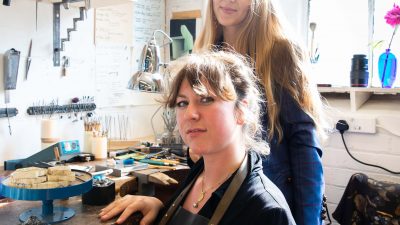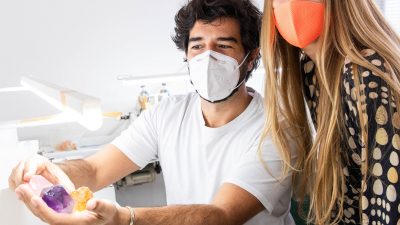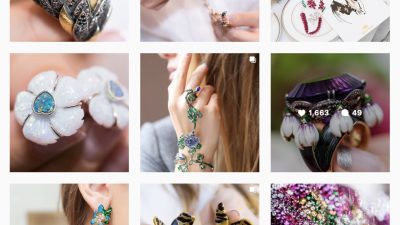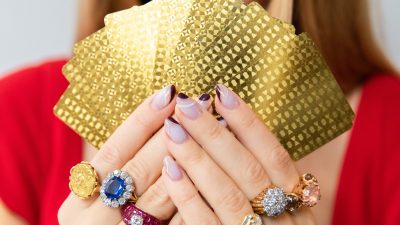THE CRAFTSMANSHIP OF SABINE ROEMER: HOW THE PARIZADE CAMEL RING CAME TO LIFE

THE CRAFTSMANSHIP OF 2022 edition… is dedicated to the fabulous craftsWOMEN that I have met on my travels around the world. In this series, I aim to debunk preconceived notions of jewellery-making as a men only craft and open the doors to some incredible female jewellery-makers. From incredible designs, wax carving to metalwork and skilful gem-setting and craftsmanship, this series will follow the journey of exquisite jewels crafted by women.
Discover THE CRAFTSMANSHIP OF… Sabine Roemer and how the Parizade Camel Ring came to life.
 SABINE ROEMER
SABINE ROEMER
I knew the moment I met Sabine Roemer for the first time in 2013 in London that she was a Jewellery Designer To Watch. Here we are nine years later, sitting at Sabine’s workbench in her home studio in London, soaking up the creative vibes and enjoying some jewellery talk. I can’t wait to show you how Sabine has evolved as a fine jewellery master.
Sabine Roemer is one of the youngest female masters to graduate from Germany’s prestigious Pforzheim Goldsmith and Watchmaking School and has won many awards for her bespoke and sculptural fine jewellery creations over the past 26 years. She is known for her work with A-List celebrities and the world’s top jewellery, fashion and couture houses, as well as her ongoing charitable work with the Nelson Mandela Foundation.

Her passion for jewellery-making began at the age of 15 and has evolved into a true dedication for the craft of jewellery. Sabine does it all, from design and metalwork to stone-cutting and gem-setting, she is a sculptor and artist in a jewellery workshop!
A skilled craftsWOMAN and master goldsmith like Sabine doesn’t need much in the way of space, just a workbench, the right tools and equipment and good lighting. The rest is talent and creativity.
Today, we’re going to be looking at the charming Parizade Camel Ring and how this whimsical character came to life, with the help of Sabine’s adorable daughter, who makes the perfect ring model! To be invited inside Sabine’s workshop and to sit beside a master jeweller in her special creative space as she takes me through the jewellery-making process was an honour and a thrill. This is where the magic happens.
View this post on Instagram
The Parizade Camel Ring is a unique piece from the Arabian Nights fine jewellery collection, handcrafted by Sabine Roemer. Inspired by the Middle Eastern book of folktales of the same name, the jewellery collection is a sculptural work of art, featuring enchanting jewels and animal characters, such as a falcon, horse and of course, a camel, each with their own set of precious jewels.
Sabine takes her medium into the world of art and creates larger pieces to be admired, not just worn. Take a look at GEMOLOGUE Instagram Jewellery Reel to see how Sabine uses her jewellery-making and goldsmithing skills to create mini sculptures and wearable art.
“When you buy from an artist/jewellery-maker, you’re buying hundreds of hours of experimentation and failure. You are buying days, weeks & months of frustration and moments of pure joy. You aren’t just buying a thing, you’re buying a piece of a heart, part of a soul, a moment of someone’s life. Most importantly, you’re buying more time for the artist to do something they are passionate about.” Sabine Roemer
CRAFTSWOMAN
It takes countless hours to become highly skilled to the point where one is capable of transforming a sketch into a high-quality jewel. To reach this kind of calibre, you need to dedicate a lot of your time to training and tutelage. It’s hard work and it’s dirty work, which may put off some women. But Sabine advises young women, who have a passion for creating jewellery, not to be discouraged. It is an industry heavily dominated by men, but do not be intimidated.

“We all can train as craftswomen and we should never let the fact that this role is heavily dominated by men intimidate us!” Sabine Roemer
The job itself is labour-intensive and you get really dirty in the workshop. Sabine joked that most days she looks like a dusty chimney, covered from head to toe from all the polishing. So it’s not a glamorous job. You’re not wearing your Dior to the workshop! Maybe that’s why there are more female jewellery designers than there are craftswomen. Going into a design studio and working on sketches is way more fun and luxurious!
“Craftswomen are like florists. We both work with our hands every day, it’s tough and your hands get rough and dirty, but we create beautiful things. I bring jewellery to life that someone will love and cherish for life and that’s priceless.” Sabine Roemer

INSPIRATION BEHIND THE JEWEL
The inspiration for the Parizade Camel Ring came from two sources: a vintage Hermes equestrian silk scarf and Princess Parizade from one of the stories in the book of Middle Eastern folktales, Arabian Nights. It is part of Sabine Roemer’s Arabian Nights high jewellery collection and was the first of many delightful animal characters. Sabine liked the idea of animals wearing jewellery, so each one is adorned in jewels.
It all started with the camel. Sabine has always found camels to be funny animals that make her smile. She wanted to create something different, something other than a butterfly, and inject a bit of humour into the piece.
“I think a camel is very funny. I wear it nearly every day, it’s like my little pet and it always makes me smile.” Sabine Roemer
The Parizade Camel Ring makes me want to smile too. It has as much character as it does charm.
DESIGN PROCESS: SCULPTING
For Sabine, her signature technique lies in her passion and skill as a sculptor. All other skills, you can train for, but sculpting and carving out different characters, giving them personality, bringing them to life, is Sabine’s favourite part of the whole creative process. She’s tried fashion and making dresses, she’s even tried cutting hair, but her hands just can’t do the fluid stuff. When she started carving in metal, though, it came naturally to her.

Sabine learned to sculpt when she was only 15, working in a metal workshop for the first time. Her boss believed in learning the hard way and that meant working with metal from the start. Carving metal is like carving stone, it’s a hard material to work with and it doesn’t allow for mistakes. If you cut away too much, there’s no going back.
This was Sabine’s first time in a workshop. She had never seen any of the tools before, not even a workbench, but after a quick tour of all the equipment, her boss set her to work on making a ring, ready for design by the end of the week. She completed the task on the first day and went on to create six more pieces in just five days. She had found her medium.
“The memories captured in precious metal are like collectible jewelled stories that can be cherished forever.” Sabine Roemer
In her second year at the workshop, Sabine discovered wax – a much more forgiving material – and that changed everything.
“That was amazing! And super easy, because if you make a mistake, you just correct it by melting the wax with a special heated pen. It’s the same with clay. When I was working on the first face of the Mandela sculptures, it was super easy. If something goes wrong, you can easily correct it.” Sabine Roemer
 CRAFTSMANSHIP
CRAFTSMANSHIP
The beauty of Sabine’s one-of-a-kind pieces is that they are created from start to finish by one pair of hands. It starts with a jewellery illustration and a block of wax:
View this post on Instagram
1. WAX CARVING
Hand-carving the wax model is one of the most important and time-consuming stages of the entire jewellery-making process. This is where the camel begins to really take shape and develop character and personality.
Sabine chooses to design the ring by hand rather than using CAD design, as crafting by hand gives the piece character and adds a human touch. It can sometimes take a few days to bring the animal to life and perfect the carving, but that’s what makes each creation one of a kind.
Sabine starts carving the ring size out of the middle of the wax block, before sculpting the animal shape around it. For this process, Sabine uses a variety of tools from special wax files to wax carving tools, as well as her favourite everyday drill. A melting tool called a “hot pin” is also used to melt and add wax as she pleases.
When Sabine is happy with the carving, the final step is to hollow out the back of the camel’s head. This will make the piece lightweight and comfortable to wear. If the head of the ring is too heavy in proportion to the ring shank, it will slide to the left or right of your finger, like so many top-heavy engagement rings. It also saves on materials and cost.

2. LOST WAX CASTING
The finished wax model is now ready for the next step – lost wax casting. This is one of the oldest jewellery-making methods, dating back to the 3rd century BC. First you place the wax carving onto a “wax tree” to hold it in place. Then a cylindrical mould fits around the wax cast before high grade plaster is added. Once set, the wax cast is melted away and replaced with silver to create a replica and a new model.

3. SILVER MODEL: FINE TUNING AND DETAILING
Working with the silver model, Sabine can add more character to the piece, shaping the face of the camel and adding details like the mini pyramids and ball decorations to the sides of the ring. Silver allows for finer detailing, which would get lost in the wax-casting process.
4. MOULD CREATION
After a few days, when all the finishing touches are complete, the ring is ready for creating the rubber mould. This is made by adding layer upon layer of rubber around the silver-cast camel ring. The rubber is then heated to form a seal around the ring to create a precise mould of the piece. This is then injected with wax to create a perfect copy of the master model. After the wax hardens, Sabine inspects the cast for quality to reveal any flaws. From this mould another lost wax is cast, which will finally be cast into gold.
5. LOST WAX CASTING OF THE FINAL PIECE IN 18-CARAT GOLD
Another lost cast is made to create the final camel ring. For this ring, 18-carat yellow gold is injected into the plaster mould and left to set. Once released from the mould, Sabine smooths out any rough edges, cleans up the gold metalwork and gives the ring a good polish.

6. ADDING THE HEAD JEWELLERY DETAILS
To make them truly unique, Sabine gives each camel its own one-of-kind head jewellery to wear. For the nose band, Sabine shapes a square bracket from wire and solders it to the nose of the camel. Working with the same wire, she forms the right shape for the gem setting for the cheek adornments, before soldering them into place. For the floral embellishment on the top of the head, Sabine carves it out of a flat sheet of 18-carat yellow gold, before soldering it in place. The ring is then brought to a high shine with a thorough pre-polish.

7. ADDING THE GOLD CHAIN AND COMPLETING THE HEAD PIECE
To make the chain more lifelike and fluid, it has to be added after the gold is cast and the ring is pre-polished. Sabine uses files, tools and drills in this process and prepares the piece for the gem-setting in Step 9.
8. ADD A BACK PLATE OF GOLD
To add comfort and ensure a natural fit on the finger, a thin 0.7mm plate of gold is formed into a dome-shape and added to the back of the ring. It needs to fit precisely into the space and is measured meticulously before soldering it into place. It is a clever way of giving the appearance of a solid gold ring, while covering up the back of the ring. This is the last time the ring will be heated and soldered. In case you need to resize the ring or heat it up again for any reason, you will have to drill a tiny hole in the back of the gold metal plate to release any trapped air. This is closed off afterwards to form a complete seal and add integrity to the structure of the ring.

9. CREATE SETTING AND SET PERIDOT, PINK TOURMALINE AND DIAMONDS
First Sabine drills the holes on the noseband for the pave diamond setting. Once the diamonds are set in place, Sabine adds the peridots and pink tourmalines to the cheek decoration to complement the yellow gold. Giving the camel its own set of jewellery to wear, Sabine turns the piece into a beautiful piece of fine jewellery. This is the last stage in creating the Parizade Camel Ring. After a thorough final polishing, the ring is now ready for its new lucky owner.

GEMSTONES & GOLD
Gem-cutting and shaping stones is at the heart of every jewellery creation. In fact, the design depends on it. And you can’t always buy the perfect gem off the shelf, so having the skill to cut and shape the stones the way you want, gives Sabine more creative freedom.

Gem-setting is another important skill to have. In the Parizade Camel Ring there are two different settings. One is called pave setting, from the French word for paved stones, which is a series of perfectly spaced out little holes for the stones to sit. They are held in place with grains of gold. The side stones and the little flower on top of the camel’s head is a bezel setting or wrap over.

For the precious metal, silver and 18-carat yellow gold were used in this model of the Parizade Camel Ring. It also comes in 18-carat white gold and platinum. Each creation produces scraps of metal, which is recycled. Every millimetre of scrap is collected in a pouch or ‘skin’ underneath the workbench and sent to a refinery for recasting. They melt down all the metal together – 9-carat, 10-carat, 24-carat gold – and refine it to an 18-carat gold state again. With this gold, the whole jewellery-making process starts all over again.
You can sign up for GEMOLOGUE newsletter below and I also share jewellery on Instagram, Twitter, Facebook and Youtube if you’d like to connect, or feel free to say hello info@gemologue.com
GEMOLOGUE jewelry blog by Liza Urla is a celebration of fine, fashion and vintage jewellery featuring talented jewellery designers, trendy urban street style, exclusive interviews and rare jewellery reviews. This jewellery blog’s goal is to encourage and educate about jewellery online in a fresh and original fashion to inspire women and men across the globe in a fashion and travelling context.
Jewellery blogger, writer Liza Urla, the founder of GEMOLOGUE, is a London-based and NYC-educated gemologist, who has travelled to and lived in many countries. She is now one of the most influential digital jewellery tastemakers. Her jewellery influence has been acknowledged by Financial Times, The New York Times, Vogue and Harper’s Bazaar.
*Styling and Art Direction by Liza Urla. All photos belong to GEM Kreatives for GEMOLOGUE.
Material on this website may not be copied, broadcasted or adapted without written consent.







